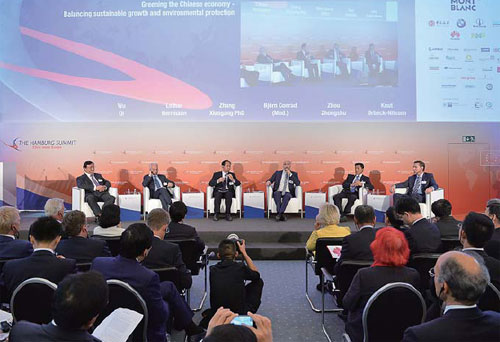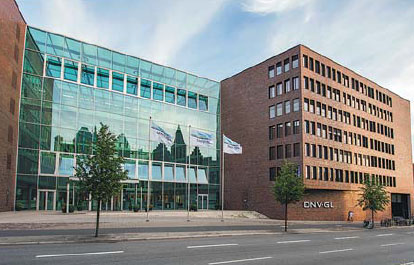DNV GL establishes new global classification standards
By Zhong Nan (China Daily) Updated: 2015-10-29 08:13
The Norwegian-German classification society DNV GL will deploy a greater number of resources and experts in China during the country's 13th Five-Year Plan (2016-20) as one of the world's largest risk management companies by revenue that undergoes an expansion amid China's industrial upgrading.
DNV GL is a globally leading classification body for the maritime, oil and gas and energy industries. It is among the top three providers of management system certification services across a wide range of industries.
Knut orbeck-Nilssen, chief executive officer of DNV GL's maritime branch based in Hamburg, said the integration of DNV and GL has gone smoothly, with most of the merger activities completed last year or coming to an end this year. "Basically, we are delivering to the schedule we set for ourselves," he said.
The company's maritime division reached a new milestone with the recent publication of DNV GL's new rule set. Keen to set a new benchmark, it involved 250 experts and more than 800 customers and maritime stakeholders in an unprecedented development and review process.
"The new rules are modern, easy to work with, efficient, and ready for the future," said orbeck-Nilssen. "We definitely believe China is a growing contribution to our business, not only over the next five years but for many more years to come.
"Not only in the traditional terms of ship classification of business, but more importantly in terms of quality of contribution."
"Even though our biggest markets are Europe-based, we are looking to grow further in the Asian and American markets, particularly in China. We see ourselves as an international classification society, and part of the strategic rationale behind the merger was to be able to expand and better serve these markets," said?rbeck-Nilssen.
Eager to enhance its customer service, DNV GL appointed dedicated experts in China for its maritime industry. Called "Technology Lighthouses", the experts provide highly competent local support to clients.
The company has also appointed a senior regional research and development manager to foster more collaboration with customers in China, including shipyards, designers, shipowners and manufacturers. Establishing joint industry projects or joint development projects will be central to this role.
DNV GL also plans to invest 5 percent of its revenue on research and innovation each year.
"In a more general innovative approach, we have introduced a new system for the fleet in service called DATE (direct access to technical experts)," said orbeck-Nilssen. "We have set up five support hubs worldwide, not just call centers, but a team of real experts who are authorized to make decisions to solve customer challenges."
He added that the company is also introducing a new portal called MyDNVGL.com.
"This is a customer interface with online access to many features. In general we are trying to become even more responsive to our customers and to bring services of real value to them," he added.
Trendsetter
DNV GL was the world's first classification society to introduce rules for the use of liquefied natural gas as ship fuel in 2000. Over the years, the company has invested substantially in research and published industry position papers to look at new trends in the maritime industry.
"We expect that the push for shipping to become greener will persist," said orbeck-Nilssen.
Last year was a milestone for the use of liquefied natural gas as ship fuel, with 100 ships either in global operation or on order. The company classed more than 65 percent of these ships.
orbeck-Nilssen said LNG will continue to grow, even though the uptake has been slower than predicted with about 153 gas-fueled vessels operating or on order.
Challenges like the underdevelopment of bunkering infrastructure remain, but there do seem to be positive moves in this direction.
"Battery and hybrid applications are very promising in some niche markets like offshore support or ferry shipping. With the automotive industry heavily invested in this technology, this development will continue," he said.
The Chinese government now has a clear plan to introduce LNG as fuel, with 170 ships having already received an approval for conversion to LNG on the Yangtze River. The central government is also planning to build ore bunkering stations, according to the Ministry of Transport in 2014.
There were approximately 172,000 commercial ships in China by the end of 2014, with more than 11,000 dedicated to inshore transportation operations, around 2,600 used in ocean transportation and the rest of smaller vessels for fishing and other commercial use.
Jing Yongping, a professor at the Beijing Institute of Petrochemical Technology, said the variety of fuels and propulsion concepts in shipping could be much greater in the future.
"It is necessary to mention that the development in all these technologies will also continue to be driven by international, national and regional regulations," said Jing.
orbeck-Nilssen said the company wants "to keep our position as the leading global classification society. But leading does not necessarily mean being the biggest in terms of gross tonnage. It means leading in quality, innovation, customer service, and safety. But as a matter of course we need a certain market position to have an impact and serve our customers with the best solutions."
zhongnan@chinadaily.com.cn
|
Knut orbeck-Nilssen (first from right on stage) takes part in a panel discussion at the Hamburg Summit held in conjunction with a visit to Germany by Premier Li Keqiang in October 2014. Photos Provided to China Daily |
|
DNV GL Maritime's headquarters in Hamburg. |

(China Daily 10/29/2015 page12)








